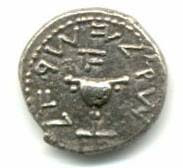Date: 32-31 BCE
Type: Silver Denarius
Obverse: Galley right.
Inscription - ANT AVG III VIR R P C. (Antonius Augurus Triumviri Rei Publicæ Constituandæ - Antony Augur Triumvir for the restoration of the Republic)
Reverse: Legionary Eagle between two standards.
Inscription: LEG XXIII (Legion 23).
Marcus Antonius (Mark Anthony) was, along with Octavian (Later Augustus) and Lepidus (The brother of L. Aemilius Lepidus Paullus a member of the Second Triumvirate.
The second Triumvirate broke up in 33 BCE when disagreement and competition between Octavian and Antony caused it to break down and end in civil war. Anthony struck this series of Legionary Denarii to pay for his legions (many of these legions he inherited from Julius Caesar).
Antony had an army composed of 30 Legions. Each Legion had up to 6,000 men plus auxiliaries and camp followers for a total of up to 160,000 soldiers. Each Legion was numbered from I to XXX.
To pay the troops each Legion had a mint that traveled with them and coined money to pay the legions, and this coin is from the mint that traveled with the 23rd Legion.
A huge number of coins were required to pay up to 160,000 men in his army. If we assume that Antony maintained the pay rate established by Caesar of 10 Asses (bronze) per day per soldier or 30 Asses per month. Pay day for the Legions occurred 3 times a year or every 4 months. At 16 Asses to the denarius (the rate at the time) we have 75 denarii 3 times a year. The payroll the traveling mints would have had to produce would have been approximately 3 million denarii a month, Or 36 million (36,000,000) per year. An impressive number of coins for the period. Paying the troops took a significant percentage of Rome's coin output so it is not surprising that the coins feature a variety of military messages upon them to maintain their loyalty and broadcast the Emperor's military virtues. Indeed keeping the soldiers well paid became a major means of remaining (or becoming) emperor in Rome, as we shall see later among the coinage and in Roman history.
This is the first of the "Legionary Denarius" series. Of all the Roman imperators, only Anthony, Gallienus, and Septimius Severus struck series of coins naming and honoring their legions.
In 31 BCE. Antony was defeated by Octavian at the naval Battle of Actium, and in a brief land battle at Alexandria, leading to the supremacy of Octavian, who changed his name to Augustus and became the first Roman Emperor.
The legionary denarii of Marcus Antonius are desirable as they are metallic commemorative of the clash of arms that led to the end of the Roman Republic and its transformation into the Roman Empire, and Antony having been immortalized in Shakespeare's Antony And Cleopatra and his end in Egypt alongside Cleopatra is well known to all.
The polity that is Brazil
53 minutes ago



No comments:
Post a Comment